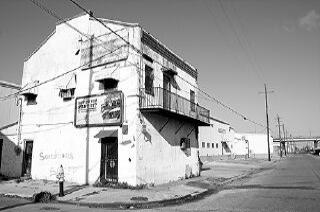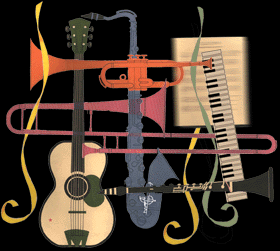| Storyville and the Birth of Jazz |
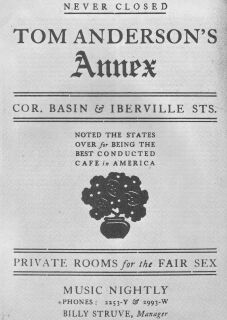
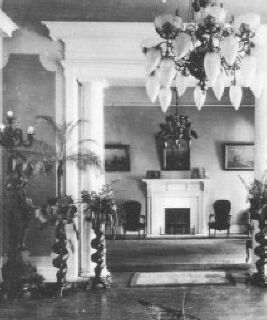
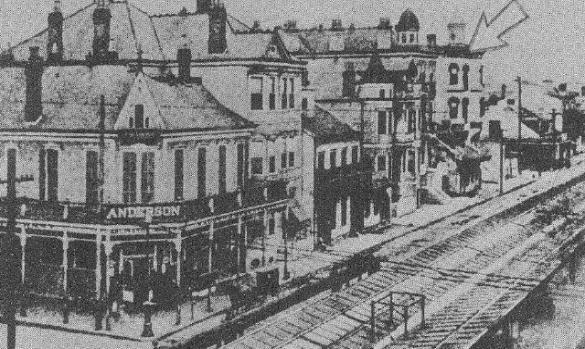
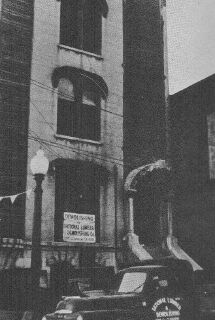
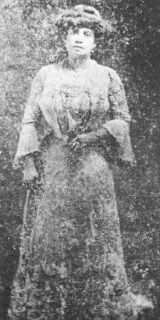
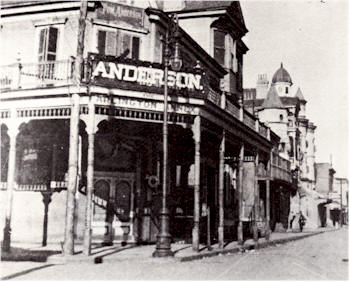
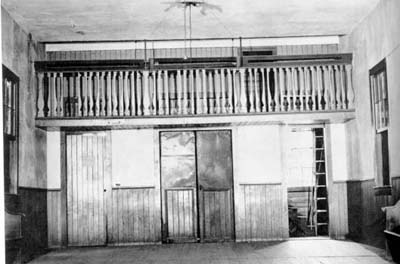
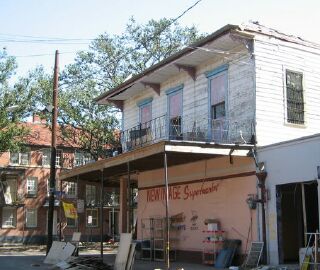
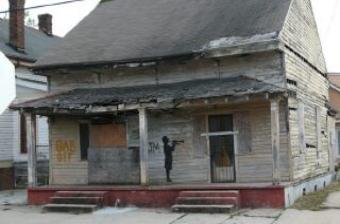
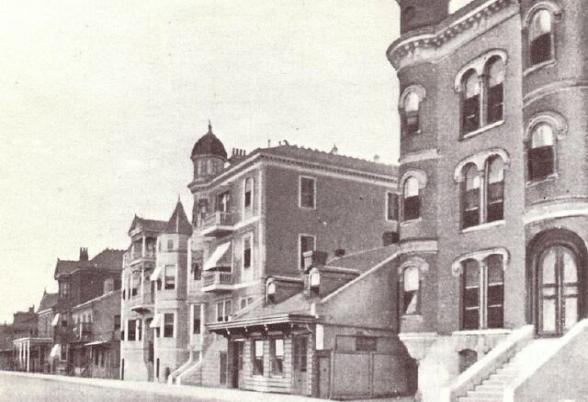
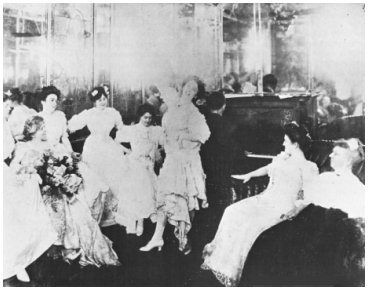
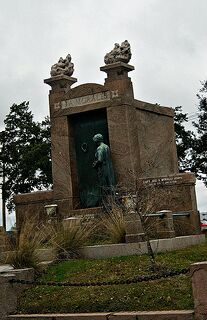
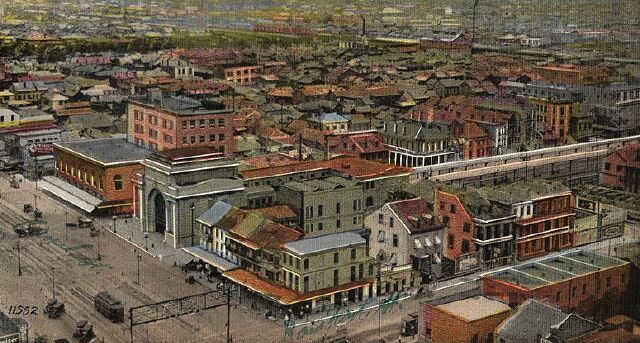
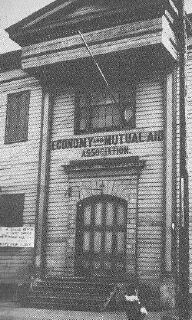
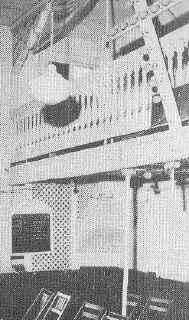
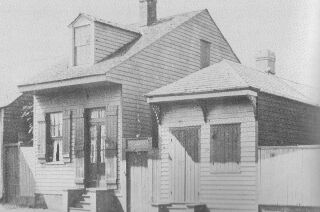
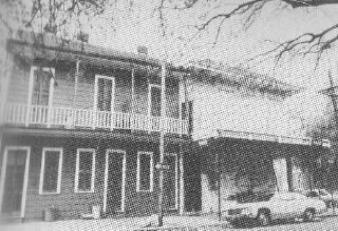
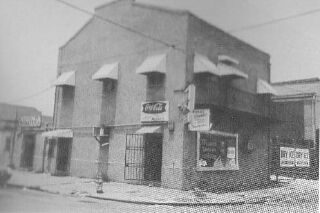
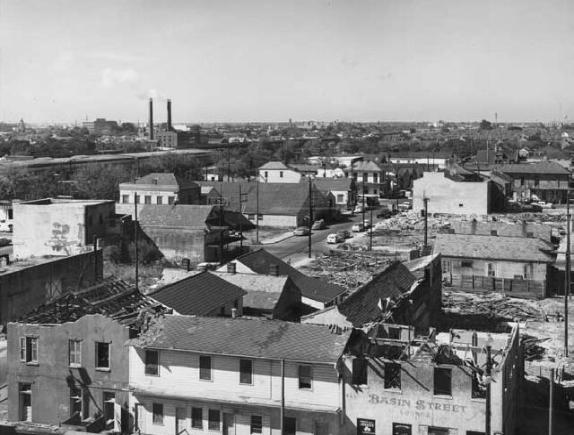
| Pictured above, in the foreground, one of Tom Anderson's saloons, at the corner of N. Basin and Iberville Streets. Mr. Anderson was considered the unofficial "mayor" of Storyville. The arrow in the upper right corner points to Lulu White's Mahogany Hall. Miss White was sometimes referred to as the Queen of Storyville. Mahogany Hall was the most expensive "sporting palace" in the District, constructed primarily of marble and mahogany, and built at a cost of $40,000. |
| Heard a bugle blowing in the rain and mist, A haunting sound over Congo Square; Thought it was the ghost of Basin Street... But when I looked, nobody was there. -- Author Unknown |
| Above, Storyville Cribs - Many of the "cribs" were nothing more than partitioned off areas of townhouses, Creole cottages or shotgun houses. Each crib rented nightly for $4 and payments for the rooms were usually made to men who ran the bars/restaurants located on almost every corner in the District. These places always featured music, as did almost every club, saloon and sporting house. Many of these houses were owned or had been owned by descendants of the original Irish, Creole, German or American citizens of the City Commons, who'd moved out and had begun renting their property even before Storyville came into being. When the District was created, some of these distinguished citizens sold their property rather than receive rent from ill-gotten gains, but many couldn't resist the prospect of collecting rent at a rate of 50 times - or more - the going price of rent in other parts of the city. It's been whispered that Storyville real estate was responsible for more than a few New Orleans fortunes. |
| We can't visit the places where Buddy Bolden, Jelly Roll Morton or the other pioneers of jazz first played America's only original form of music. Just a few structures from the Storyville era remain. Most were demolished in the 1930's, to make way for the Iberville Housing Project, which takes up almost the entire area that was Storyville. The photo above shows more demolition on Basin Street and beyond in the 1950's. |
Storyville, the legalized Red Light District of early 20th century New Orleans, was made
up of only sixteen square blocks and lasted just 20 years. But the echoes of the music
nurtured there can still be heard all over the world.
I use the word 'nurtured,' as opposed to 'created' in Storyville, because, although many
credit that District as the location of the birth of jazz, in truth, jazz was being created and
re-created in many neighborhoods across the city. But Storyville played an important
role in the music's development, giving some of the originators of this innovative music
the opportunity to come together in the halls, saloons and brothels of the District to
nurture this new genre.
In 1897, Alderman Sidney Story proposed legislation to limit prostitution to the area
between North Robertson and North Basin streets, and from Customhouse (now Iberville)
to St. Louis streets. The city council passed the ordinance and the citizens of the city
"looked forward to an era of improvement and stability as a result."
Clearly, the council's focus was in restricting vice to a "manageable" area. The
experiment may not have worked out exactly as they'd intended, but little could they have
imagined that they were setting the stage for a phenomenon that would make its way
around the world, one which will last as long as the world appreciates great music.
-- Nancy
up of only sixteen square blocks and lasted just 20 years. But the echoes of the music
nurtured there can still be heard all over the world.
I use the word 'nurtured,' as opposed to 'created' in Storyville, because, although many
credit that District as the location of the birth of jazz, in truth, jazz was being created and
re-created in many neighborhoods across the city. But Storyville played an important
role in the music's development, giving some of the originators of this innovative music
the opportunity to come together in the halls, saloons and brothels of the District to
nurture this new genre.
In 1897, Alderman Sidney Story proposed legislation to limit prostitution to the area
between North Robertson and North Basin streets, and from Customhouse (now Iberville)
to St. Louis streets. The city council passed the ordinance and the citizens of the city
"looked forward to an era of improvement and stability as a result."
Clearly, the council's focus was in restricting vice to a "manageable" area. The
experiment may not have worked out exactly as they'd intended, but little could they have
imagined that they were setting the stage for a phenomenon that would make its way
around the world, one which will last as long as the world appreciates great music.
-- Nancy
| Above, a closer look at one of Tom Anderson's establishments and, right, an ad for it. |
| Above and right, famous Storyville madam, Lulu White; below, left, interior of Mahogany Hall in its heyday; below, right, just before it was demolished. |
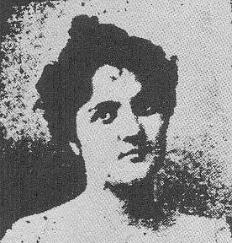
| The pianist in this photo of Hilma Burt's Storyville bordello is said to be none other than famous jazz great, Jelly Roll Morton. Hilma Burt is seated at left, and her housekeeper, seated, at right. |
| Right, the tomb of Storyville madam, Josie Arlington, was designed by Ms. Arlington. The statue is of a woman knocking at a door. Various theories have been postulated about the significance of the design. Some say it represents Josie knocking at her family's door (mortified at her choice of professions, they'd disowned her many years before). After the tomb was erected, strange reports started surfacing. Passersby claimed that the two torches at the top of the tomb glowed red; some said the statue moved. It became quite an attraction and, embarrassed by the notoriety it was causing, her family had Josie's remains moved and interred in a more private resting place. However, the reports of activity at the tomb continued for many years. It was determined that the folks who said they saw the torches glowing red were correct -- they were reflecting the gleam of a light situated on the banks of a nearby canal. |
| A postcard view of The District. |
| In the Storyville era, this was Joe Victor's Saloon, St. Louis Street; photo on left, 1970's; photo on right is recent and is courtesy of Anthony Lee Posey and Flickr Commons. |
| Left, former home of Frank Early's Saloon (on the corner) on Bienville Street and the building behind it, which was partitioned into ten cribs in the Storyville era. Until it was flooded in 2005, Early's saloon had been a grocery store for many years. Right, it can be seen after the levee failures. |
| Social clubs played a vital role in the development of jazz. Above & below, the Economy and Mutual Aid Association (known as Economy Hall), exterior and interior. |
| "Banksy" - the famous urban artist, made a trip to New Orleans after the flood and left many interesting and poignant illustrations behind. Here, on a flooded out, boarded up house in Treme, the lone figure of a small child blowing a horn appears. |
| Above photo is courtesy of Infrogmation at Wikimedia Commons. |
| Photo above, right is courtesy of Infrogmation and Wikimedia Commons. |
| Photo above is courtesy of Infrogmation and Wikimedia Commons. |
| Image above is courtesy of Infrogmation and Wikimedia Commons. |
